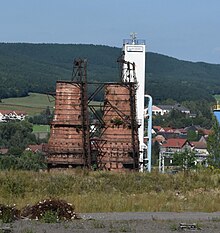Maxhütte (Unterwellenborn)
The Maxhütte in Unterwellenborn , Thuringia, was a steel and rolling mill that was built in the second half of the 19th century. After several changes of name and ownership, it came to an end in 1992. The Thuringia steelworks has existed here since 1995 .
history
Maxhütte
The Maxhütte in Unterwellenborn was put into operation in 1872 as a branch of the Maximilianshütte in Sulzbach-Rosenberg in Upper Palatinate . With the cessation of the pig iron production of the Queen Marienhütte in the Saxon town of Cainsdorf near Zwickau , the block delivery contract that the Maxhütte in Unterwellenborn had with the Königin-Marienhütte in Cainsdorf ended in 1893. The general director of the Maxhütte in Rosenberg decided to build a steelworks with an attached rolling mill on the area south-west of the Zwickau main train station , which then belonged to the Lichtentanne community . This steelworks, known as the König-Albert-Werk , in the Maxhütte district of Zwickau today, was in operation between 1898 and 1930. Pig iron was supplied from Unterwellenborn. The three converters were relocated to Unterwellenborn after the closure of the König Albert plant in Lichtentanne.
From 1921 to 1946 the factory in Unterwellenborn was part of the Flick Group . As of 1936, as part of the Nazi regime's preparations for war, the plant was completely converted to armaments production. During the Second World War , numerous prisoners of war and forced labor from the countries occupied by Germany were used here.
On June 5, 1946, the plant was expropriated and initially operated as a SAG company , and from July 1, 1948 as a state-owned company (VEB Bergbau- und Hüttenkombinat Maxhütte). In the winter months of 1948/49 approx. 2,700 young people followed the FDJ's call for a youth project entitled Max needs water! with the aim of building a five-kilometer long-distance water line from the Saale to the plant within three months. The cooling water was urgently needed for production. Since the manpower was insufficient due to the lack of work equipment, hundreds of students from the surrounding areas were also hired as construction workers. Later the FDJ initiative Max Needs Scrap or Max Needs Bones was issued. The former also fell some steel structures, e.g. B. disused railway bridges, victim.
Initially, Maxhütte was the only pig iron producer in the Soviet occupation zone , as the other steelworks in Brandenburg an der Havel , Gröditz , Riesa , Hennigsdorf and Freital had been dismantled and transported away as reparations for the Soviet Union . At its peak, the Maxhütte had over 7,000 employees. Among other things, the S49 railroad track for the Deutsche Reichsbahn was manufactured here. Until 1987 there was a specially set up labor camp for forced labor near the steelworks, in which criminal and political prisoners of the SED regime were housed. There, among others, the GDR oppositionist Arnold Vaatz was a slave laborer.
After the reunification in the GDR , on July 1, 1990 the VEB became a GmbH owned by the Treuhandanstalt . After the premises on 17 March 1992 to the Luxembourg Arbed had been sold group, the last was on 10 July 1992 blast furnace - racking performed, whereby a 120-year history of iron production was terminated.
After the Maxhütte
The new electric steelworks with 650 employees went into operation on November 11, 1995 , now under the name Stahlwerk Thüringen GmbH . Since the merger of several steel manufacturers in 2001, the plant has belonged to the Arcelor Group. The Maxhütte Unterwellenborn itself was deleted from the commercial register in the summer of 1996.
In the summer of 2006, the new parent company Arcelor became part of the Mittal Group of the Indian steel manufacturer Lakshmi Mittal . Due to a stipulation by the Cartel Office, the Thuringia steelworks was sold again by Mittal in January 2007 for competitive reasons, for 590 million euros to the Spanish Grupo Alfonso Gallardo. In February 2012, the Brazilian Companhia Siderúrgica Nacional (CSN) took over the plant.
Movie
- The Maxhütte in Unterwellenborn, MDR documentation from the series " Search for traces in ruins" , 2008
Web links
- History of the Unterwellenborn steel site on the homepage of Stahlwerk Thüringen GmbH
- Railway vehicles from Stahlwerk Thüringen GmbH
- On the history of the gas engine center of the Maxhütte and the traditional GMZ association of the Maxhütte
- Learning location "Viewing monument gas engine center"
Coordinates: 50 ° 39 ′ 6 ″ N , 11 ° 26 ′ 15 ″ E
Individual evidence
- ↑ The König-Albert-Werk on www.albert-gieseler.de
- ^ Study: Forced labor in 600 GDR companies
- ↑ Film documentary: Searching for traces in ruins by Anna Schmidt, MDR 2008 production
- ↑ Biography at the German Bundestag
- ↑ Arnold Vaatz in the Munzinger archive ( beginning of article freely accessible)
- ↑ Archived copy ( memento of the original dated August 9, 2009 in the Internet Archive ) Info: The archive link was inserted automatically and has not yet been checked. Please check the original and archive link according to the instructions and then remove this notice. , accessed December 8, 2012.
- ↑ From the Sugar Loaf to East Germany. More and more Brazilian companies are reluctant to invest in Germany . In: FAZ, December 3, 2012, p. 17.





